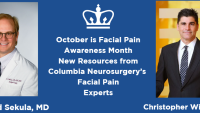Hemifacial Spasm
Make an Appointment
Our team of dedicated access representatives is here to help you make an appointment with the specialists that you need.
Hemifacial Spasm is a neurological condition in which the muscles on one side of the face begin to involuntarily twitch or contract.
Watch Dr. Sekula explain hemifacial spasm:
The intensity of this condition can vary widely and while it occurs in both men and women, it more commonly affects middle-aged to elderly women.
Symptoms
Symptoms include involuntary muscle spasms or twitching of the muscles, usually on just one side of the face. Symptoms often begin with mild intermittent twitching of one eyelid and may progress to the lower face. In more severe cases, this then progresses to more intense and continuous muscle spasms on one whole side of the face.
Risk Factors
Usually hemifacial spasm is caused by some kind of injury to or pressure on the facial nerve. There are two facial nerves that come directly off of the brain stem and enter the face just in front of the ear. One on each side, these nerves control the muscles of facial expression.
One common cause of pressure on the facial nerve is the presence of an enlarged blood vessel. More rarely, a tumor can be the cause of the pressure.
In some cases, no apparent cause can be determined.
Treatments
The first line of treatment is usually drug therapy to relax muscles. This can be by way of oral medications such as clonazepam, diazepam, and levodopa, or via injections into the muscles with botox. In cases that are not adequately controlled with botox injections, a surgical procedure, microvascular decompression, is often considered.
The prognosis for each patient varies according to the severity of the condition. Some patients are successfully managed with minimal intervention. Others require more than one form of treatment before they are free of the condition. Still others, may continue to require ongoing treatment to relieve their muscle spasms.
